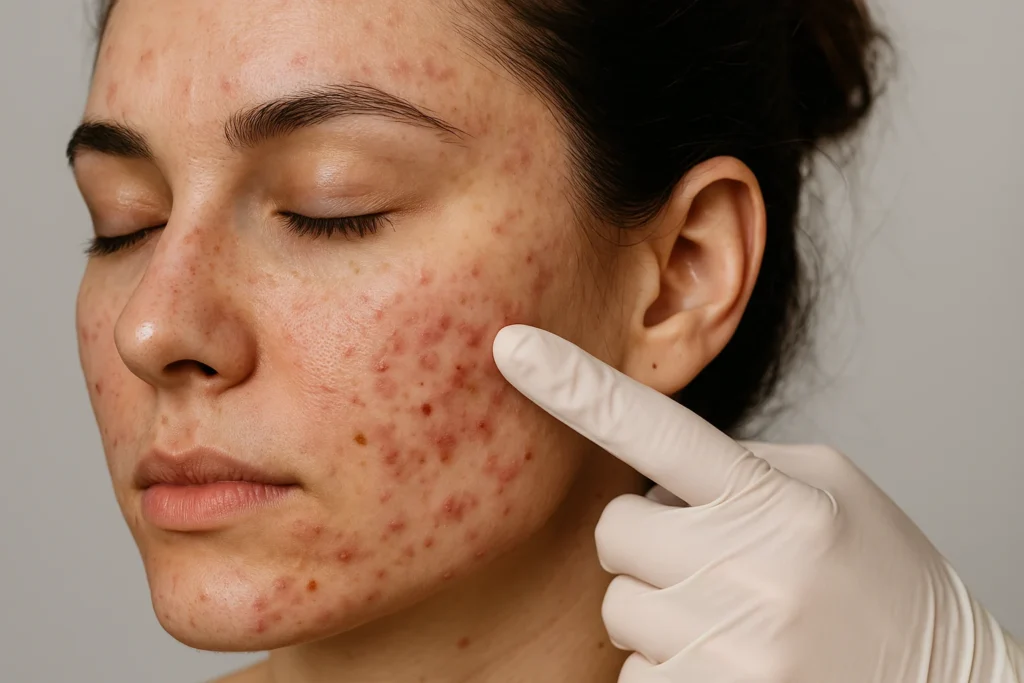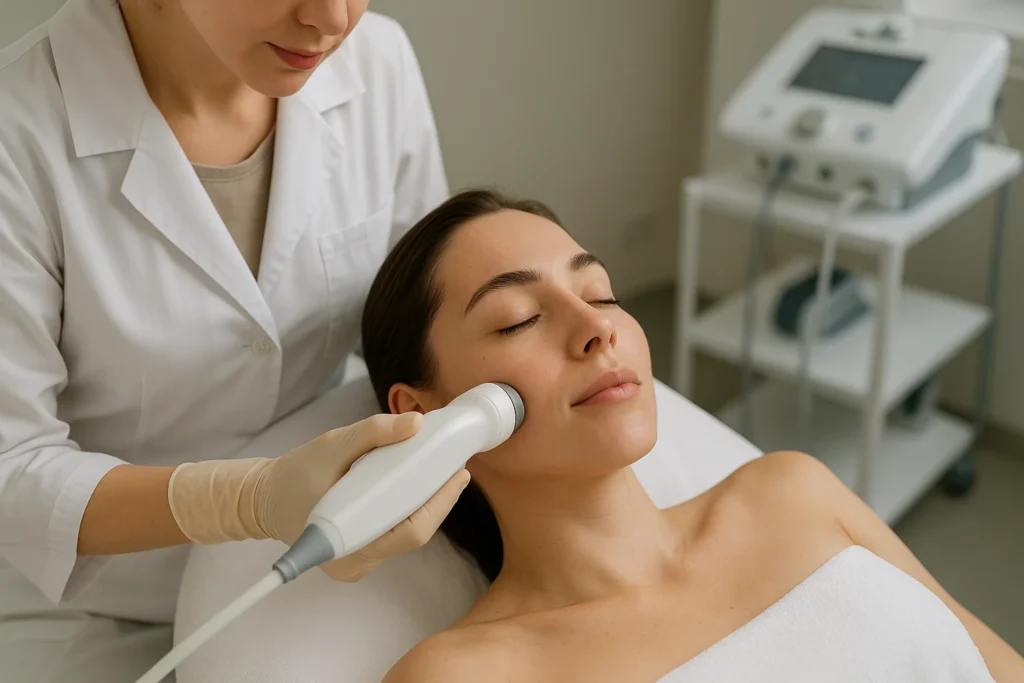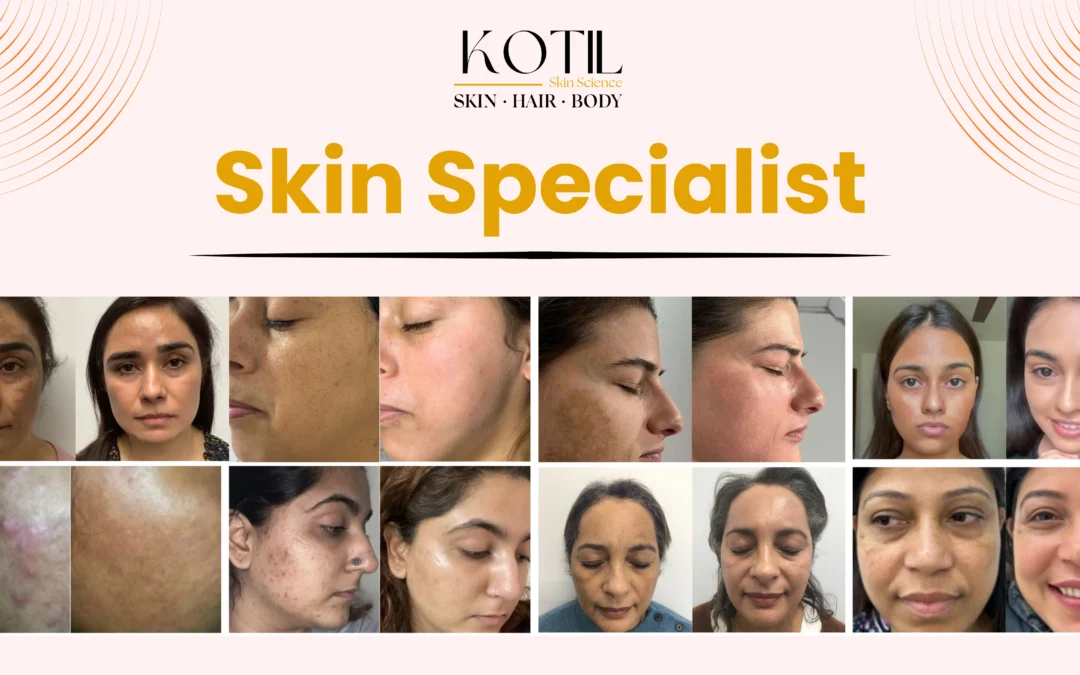Introduction
If you’re searching for a skin specialist you can trust, this guide gives you clear, India-focused answers. You’ll learn when to consult a doctor, which treatments actually work (including Pigmentation Treatment and Melasma Treatment), what to expect during visits, and how to choose the right clinic. The goal is simple: help you make safe, confident decisions for long-term skin health.
What a skin specialist actually does
A skin specialist evaluates, diagnoses, and treats conditions of the skin, hair, and nails. Beyond prescribing creams, they use medical history, dermatoscopic examination, and evidence-based procedures to solve problems like acne, scars, pigmentation, melasma, eczema, hair fall, and early aging. Because Indian skin is more prone to tanning, inflammation, and post-inflammatory hyperpigmentation (PIH), a doctor’s personalized plan prevents trial-and-error damage and saves time.

Signs you should see a skin specialist soon
- Acne that keeps returning, leaves marks, or flares around periods
- Dark patches, uneven tone, or stubborn sun tan
- Itchy rashes, allergies, or recurring fungal infections in humid months
- Thinning hair, dandruff, or sudden hair fall
- Visible pores, rough texture, or early fine lines
- Non-healing spots or changing moles that worry you
- Persistent under-eye darkness or melasma after pregnancy or hormone changes
As a rule, if a concern lasts beyond two to three weeks—or affects your confidence—book a clinical evaluation with a skin specialist.
for healthy, glowing skin & hair.
What happens during your first consultation
- Medical and lifestyle review: diet, sleep, stress, sun exposure, periods, medications, and previous reactions.
- Skin examination: texture, barrier health, acne type, pigment depth, and triggers using a dermatoscope when needed.
- Diagnosis and plan: stepwise care that combines home routine with clinic treatments, explained in simple language.
- Safety briefing: patch tests where appropriate, realistic timelines, and after-care instructions.
- Follow-up: photos to track progress and adjust treatment intensity conservatively for Indian skin types.

Clinic treatments that deliver visible results
Pigmentation Treatment (for tan, spots, uneven tone)
Effective Pigmentation Treatment usually blends:
- Medical brightening such as azelaic acid, kojic acid, arbutin, vitamin C, and sometimes oral tranexamic, chosen after evaluation.
- Chemical peels (glycolic, salicylic, mandelic, or TCA by strength) to lift dull, pigmented layers safely.
- Laser or light devices targeted at pigment clusters, performed with conservative settings to avoid PIH.
- Daily photoprotection with broad-spectrum SPF 50 and PA+++ plus hats or shade during peak sun.
Results are progressive; expect noticeable brightening over 6–12 weeks when you follow after-care.
Melasma Treatment (gentle, consistent, sunscreen-centric)
Melasma Treatment is more delicate because hormones, heat, and sun can trigger relapse. Doctors typically use:
- Low-irritant brighteners (azelaic, arbutin, niacinamide) in cycles to preserve barrier health.
- Careful device work such as low-fluence lasers or fractional options only when indicated.
- Strict sunscreen discipline and lifestyle changes (shade, cooling measures, reduced heat exposure from kitchen/workouts).
- Maintenance plans to prevent rebound, because melasma needs ongoing control rather than a quick fix.
Acne, scars, and pores
- Active acne responds to retinoids, targeted antibiotics when needed, anti-inflammatory peels, and oil-control routines.
- Atrophic scars improve with microneedling RF, fractional lasers, subcision, and PRP; multiple sessions yield best results.
- Large pores and texture benefit from controlled resurfacing and daily retinoids.
Anti-aging, glow, and hydration
- Collagen stimulation with microneedling RF or fractional lasers
- Office medi-facials and hydradermabrasion for an instant, event-ready boost
- Toxin and fillers for lines and contouring, administered by trained doctors only
Hair and scalp
- Hair fall protocols use PRP or growth-factor therapy, low-level laser therapy, nutrition guidance, and medical serums.
- Dandruff requires anti-fungal shampoos, scalp hygiene, and seasonal maintenance.
How long will it take to see results?
- Weeks 1–2: barrier reset, reduced irritation, first peel or device session (if suitable)
- Weeks 3–6: visible clarity, smoother texture, milder breakouts
- Weeks 8–12: pigment reduction, improved scars, firmer look
- Maintenance: sunscreen, actives, and periodic reviews to hold results
Consistency is the success multiplier. A skin specialist spaces sessions safely and adjusts strength only when your skin is ready.
Safety and side-effect prevention
Reputable clinics prioritize:
- Qualified doctors with experience in Indian skin
- Sterile instruments and single-use consumables
- Conservative energy settings and patch tests
- Clear pre- and post-procedure instructions (no sun, no gym/steam on treatment day, soothing creams, SPF)
- Emergency protocols and transparent consent forms
If a clinic can’t explain how they customize Pigmentation Treatment versus Melasma Treatment, consider that a red flag.

Daily routine a skin specialist may prescribe
Morning: gentle cleanser → antioxidant/brightener serum → moisturizer (if needed) → broad-spectrum sunscreen SPF 50, PA+++
Evening: cleanser → treatment active (retinoid or azelaic/niacinamide as advised) → barrier-support moisturizer
Weekly: clinic peel or home peel pads only if your doctor approves
Lifestyle: 7–8 hours sleep, protein-rich diet, hydration, regular exercise, and stress management
Sunscreen is non-negotiable. It protects your investment in every Pigmentation Treatment and Melasma Treatment.
How to choose the right clinic in India
- Credentials: dermatologist or cosmetic physician with verifiable training
- Track record: clear before-after photos across diverse concerns
- Technology: medical-grade lasers, microneedling RF, dermatoscopes, and cooling systems
- Counselling: realistic timelines, written after-care, and a focus on safety
- Reviews and reputation: patient stories that talk about both results and care quality
- Clarity on costs: transparent packages with session counts and maintenance guidance
Why many patients choose Kotil Skin Science
Kotil Skin Science is a doctor-led centre for Cosmo-Aesthetic Treatments across all skin and hair laser treatments. The team emphasizes conservative, evidence-based protocols suitable for Indian skin tones, personalized plans for Pigmentation Treatment and Melasma Treatment, and measurable milestones so patients can see steady progress. If you’re ready for a structured plan from a skin specialist, this is where your journey can begin.
Book Appointment for healthy, glowing skin & hair.
Practical scenarios: when a skin specialist helps most
- Bridal or event countdown: 8–12 weeks for pigment, texture, and glow plans
- Post-acne marks: control new breakouts, then treat marks and scars
- Post-pregnancy melasma: slow and gentle maintenance with strict sun discipline
- Office-goers with screen time: antioxidant care, blue-light awareness, and regular SPF reapplication
- Outdoor workers and athletes: sweat-resistant sunscreen, shade strategy, and calming actives
FAQ’s
1) How many sessions will I need for visible results?
It depends on concern and depth. Many patients notice change within 4–8 weeks, with larger improvements by 12 weeks.
2) What should I avoid after procedures?
Direct sun, sauna/steam, intense workouts the same day, harsh scrubs, and new actives unless your doctor clears them.
3) Can I wear makeup after a peel or laser?
Light makeup is typically fine after 24–48 hours, depending on the procedure and your doctor’s advice.
4) What sunscreen is best post-treatment?
Broad-spectrum SPF 50 with PA+++ in a texture you’ll reapply: gel for oily, lotion/cream for dry, and tinted options for blending.
5) Will a skin specialist treat dandruff and hair fall too?
Yes. Scalp conditions and hair loss are part of dermatology, and treatment may include medicated shampoos, PRP/GF therapy, and nutrition guidance.
6) I have sensitive skin. Can I still do peels?
Often yes, with gentle acids like mandelic or lactic and longer gaps between sessions. Patch testing is important.
7) How much downtime should I plan for?
Most office procedures are lunchtime treatments with minimal downtime; your doctor will set expectations beforehand.
8) How do I choose between clinic facials and medi-facials?
Medi-facials are protocol-driven, device-assisted, and supervised by a doctor; they’re safer for acne-prone or sensitive skin.
Conclusion
Healthy, glowing skin begins with an accurate diagnosis and a plan you can follow. A skin specialist brings medical insight, safe technology, and personalized care together—especially valuable for complex concerns like pigmentation and melasma.
for healthy, glowing skin & hair.

